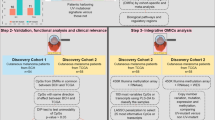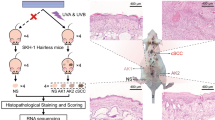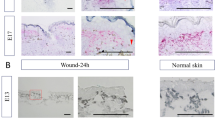Abstract
Ercc1 has an essential role in the nucleotide excision repair (NER) pathway that protects against ultraviolet (UV)-induced DNA damage and is also involved in additional repair pathways. The premature death of simple Ercc1 mouse knockouts meant that we were unable to study the role of Ercc1 in the skin. To do this, we have used the Cre–lox system to generate a skin-specific Ercc1 knockout. With a Cre transgene under control of the bovine keratin 5 promoter we achieved 100% recombination of the Ercc1 gene in the epidermis. Hairless mice with Ercc1-deficient skin were hypersensitive to the short-term effects of UV irradiation, showing a very low minimal erythemal dose and a dramatic hyperproliferative response. Ultraviolet-irradiated mice with Ercc1-deficient skin developed epidermal skin tumours much more rapidly than controls. These tumours appeared to arise earlier in actinic progression and grew more rapidly than tumours on control mice. These responses are more pronounced than have been reported for other NER-deficient mice, demonstrating that Ercc1 has a key role in protecting against UV-induced skin cancer.
This is a preview of subscription content, access via your institution
Access options
Subscribe to this journal
Receive 50 print issues and online access
$259.00 per year
only $5.18 per issue
Buy this article
- Purchase on SpringerLink
- Instant access to full article PDF
Prices may be subject to local taxes which are calculated during checkout






Similar content being viewed by others
References
Berg RJ, de Vries A, van Steeg H, de Gruijl FR . (1997). Cancer Res 57: 581–584.
Berg RJ, Rebel H, van der Horst GTJ, van Kranen HJ, Mullenders LH, van Vloten WA et al. (2000). Cancer Res 60: 2858–2863.
Canfield PJ, Greenoak GE, Macasaet EN, Reeve VE, Gallagher CH . (1988). Pathology 20: 109–117.
Chipchase MD, Melton DW . (2002). DNA Repair 1: 335–340.
de Boer J, van Steeg H, Berg RJ, Garssen J, de Wit J, van Oostrom CT et al. (1999). Cancer Res 59: 3489–3494.
de Vries A, Berg RJ, Wijnhoven S, Westerman A, Wester PW, van Kreijl CF et al. (1998). Oncogene 16: 2205–2212.
de Vries A, van Oostrom CT, Hofhuis FM, Dortant PM, Berg RJ, de Gruijl FR et al. (1995). Nature 377: 169–173.
Friedberg EC . (2001). Nat Rev Cancer 1: 22–33.
Gallagher CH, Canfield PJ, Greenoak GE, Reeve VE . (1984). J Invest Dermatol 83: 169–174.
Hsia K-T, Millar MR, King S, Selfridge J, Redhead NJ, Melton DW et al. (2003). Development 130: 369–378.
Itoh T, Cado D, Kamide R, Linn S . (2004). Proc Natl Acad Sci USA 101: 2052–2057.
Kuhn R, Torres RM . (2002). Methods Mol Biol 180: 175–204.
Magin TM, McEwan C, Milne M, Pow AM, Selfridge J, Melton DW . (1992). Gene 122: 289–296.
Mansour SL, Thomas KR, Capecchi MR . (1988). Nature 336: 348–352.
McWhir J, Selfridge J, Harrison DJ, Squires S, Melton DW . (1993). Nat Genet 5: 217–224.
Moore RC, Redhead NJ, Selfridge J, Hope J, Manson JC, Melton DW . (1995). Bio/Technology 13: 999–1004.
Nakane H, Takeuchi S, Yuba S, Saijo M, Nakatsu Y, Murai H et al. (1995). Nature 377: 165–168.
Nunez F, Chipchase MD, Clarke AR, Melton DW . (2000). FASEB J 14: 1073–1082.
Ramirez A, Bravo A, Jorcano JL, Vidal M . (1994). Differentiation 58: 53–64.
Ramirez A, Page A, Gandarillas A, Zanet J, Pibre S, Vidal M et al. (2004). Genesis 39: 52–57.
Remenyik E, Wikonkal NM, Zhang W, Paliwal V, Brash DE . (2003). Oncogene 22: 6369–6376.
Sands AT, Abuin A, Sanchez A, Conti CJ, Bradley A . (1995). Nature 377: 162–165.
Selbert S, Bentley DJ, Melton DW, Rannie D, Lourenco P, Watson CJ et al. (1998). Transgenic Res 7: 387–396.
Selfridge J, Hsia K-T, Redhead NJ, Melton DW . (2001). Nucleic Acids Res 29: 4541–4550.
Selfridge J, Pow AM, McWhir J, Magin TM, Melton DW . (1992). Somat Cell Mol Genet 18: 325–336.
Stacey A, Schnieke A, McWhir J, Cooper J, Colman A, Melton DW . (1994). Mol Cell Biol 14: 1009–1016.
Thompson S, Clarke AR, Pow AM, Hooper ML, Melton DW . (1989). Cell 56: 313–321.
van der Horst GT, van Steeg H, Berg RJ, van Gool AJ, de Wit J, Weeda G et al. (1997). Cell 89: 425–435.
van Schanke A, Jongsma MJ, Bisschop R, van Venrooij GM, Rebel H, de Gruijl FR . (2005). J Invest Dermatol 124: 241–247.
Acknowledgements
Ultraviolet dosimetry was carried out by Dr Stephen Pye (Lothian University Hospitals NHS Trust). The Ercc1 gene targeting was carried out by Kan-Tai Hsia. Ercc1 skin-specific knockout mice were produced with the support of a programme Grant (SP2095/0301) from Cancer Research UK to DWM. The UV irradiation work on these mice was supported by a project grant from the Association for International Cancer Research to DWM. NJL was supported by a PhD scholarship from the Raven Trust.
Author information
Authors and Affiliations
Corresponding author
Additional information
Supplementary Information accompanies the paper on the Oncogene website (http://www.nature.com/onc).
Rights and permissions
About this article
Cite this article
Doig, J., Anderson, C., Lawrence, N. et al. Mice with skin-specific DNA repair gene (Ercc1) inactivation are hypersensitive to ultraviolet irradiation-induced skin cancer and show more rapid actinic progression. Oncogene 25, 6229–6238 (2006). https://doi.org/10.1038/sj.onc.1209642
Received:
Revised:
Accepted:
Published:
Issue date:
DOI: https://doi.org/10.1038/sj.onc.1209642
Keywords
This article is cited by
-
Transcriptional profiling reveals progeroid Ercc1 -/Δ mice as a model system for glomerular aging
BMC Genomics (2013)
-
Smad4 Loss in Mouse Keratinocytes Leads to Increased Susceptibility to UV Carcinogenesis with Reduced Ercc1-Mediated DNA Repair
Journal of Investigative Dermatology (2013)
-
Deficient expression of DNA repair enzymes in early progression to sporadic colon cancer
Genome Integrity (2012)
-
A novel transcript for DNA repair gene Ercc1 in mouse skin
Transgenic Research (2011)



